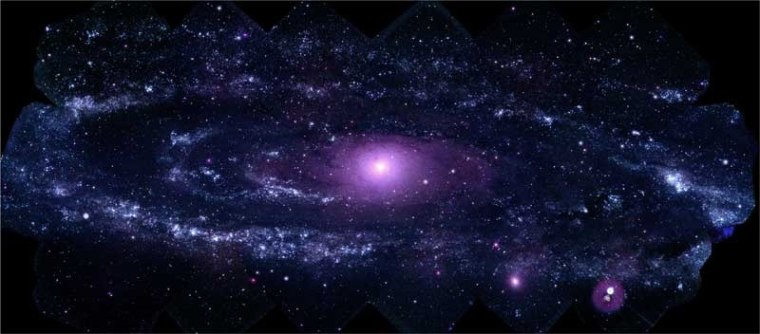A new view of the Andromeda Galaxy reveals hot, young stars in ultraviolet light.
NASA's Swift satellite acquired the highest-resolution view of a neighboring spiral galaxy ever attained in the ultraviolet, according to NASA. The galaxy, known as M31 in the constellation Andromeda, is the largest and closest spiral galaxy to our own.
"Swift reveals about 20,000 ultraviolet sources in M31, especially hot, young stars and dense star clusters," said Stefan Immler, a research scientist on the Swift team at NASA's Goddard Space Flight Center. "Of particular importance is that we have covered the galaxy in three ultraviolet filters. That will let us study M31's star-formation processes in much greater detail than previously possible."
The Andromeda Galaxy, is more than 220,000 light-years across and lies 2.5 million light-years away. On a clear, dark night, the galaxy is faintly visible as a misty patch to the naked eye.
Andromeda and our own Milky Way Galaxy are expected to collide in a few billion years.
The new image, released this week, were made from 330 observations done last year during a total of 24 hours of observing time.
The task of assembling the resulting 85 gigabytes of images fell to Erin Grand, an undergraduate student at the University of Maryland at College Park who worked with Immler as an intern this summer. "After ten weeks of processing that immense amount of data, I'm extremely proud of this new view of M31," she said.
Several features are immediately apparent in the new mosaic. The first is the striking difference between the galaxy's central bulge and its spiral arms. "The bulge is smoother and redder because it's full of older and cooler stars," Immler explained. "Very few new stars form here because most of the materials needed to make them have been depleted."
Dense clusters of hot, young, blue stars sparkle beyond the central bulge. As in our own galaxy, M31's disk and spiral arms contain most of the gas and dust needed to produce new generations of stars. Star clusters are especially plentiful in an enormous ring about 150,000 light-years across.
What triggers the unusually intense star formation in Andromeda's "ring of fire"? Previous studies have shown that tides raised by the many small satellite galaxies in orbit around M31 help boost the interactions within gas clouds that result in new stars.
In 1885, an exploding star in M31's central bulge became bright enough to see with the naked eye. This was the first supernova ever recorded in any galaxy beyond our own Milky Way.
"We expect an average of about one supernova per century in galaxies like M31," Immler said. "Perhaps we won't have to wait too long for another one."
